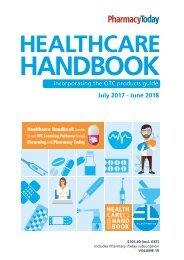2017 HCHB_digital
Create successful ePaper yourself
Turn your PDF publications into a flip-book with our unique Google optimized e-Paper software.
Wound Care<br />
Our skin acts as a barrier to the outside world, protecting us from infection,<br />
temperature extremes and UV radiation; and internal organs and other structures<br />
from damage. A wound is a break in the skin which may be caused by cuts<br />
or abrasions (see also Cuts, Abrasions and Blisters), surgery, cancer, burns,<br />
trauma to fragile skin, penetrating objects, pressure sores, skin ulcers, and many<br />
other things. Some people are more prone to wounds, such as elderly people,<br />
people with diabetes, and people taking corticosteroids.<br />
Most wounds heal faster and with less scarring if the wound is kept moist.<br />
Modern dressings containing hydrogels and other substances prevent wounds<br />
from drying out and absorb fluid (exudate) from weeping wounds.<br />
Serious wounds often need long-term treatment and patients are usually<br />
under the ongoing care of a nurse and/or doctor. However, patients may wish to<br />
buy dressings at the pharmacy.<br />
Initial assessment<br />
If a customer presents to your pharmacy with an acute wound, get them to stem<br />
TREATMENT OPTIONS<br />
Category Examples Comments<br />
Sanitising products eg, MicroCleanz Eliminates most common harmful germs and bacteria. Convenient alternative to<br />
hand washing.<br />
Saline for cleansing<br />
[GENERAL SALE]<br />
eg, saline 0.9% (GP Wound Wash Saline)<br />
Normal saline (saline 0.9%) or tap water have similar outcomes when used to clean<br />
wounds.<br />
Antiseptic wound care<br />
applications<br />
Products to stop bleeding<br />
Wound healing products<br />
Dressings<br />
Topical anaesthetics<br />
[GENERAL SALE]<br />
benzalkonium chloride (eg, Bepanthen, Dettol Antiseptic<br />
Wound Wash Spray)<br />
bufexamac + chlorhexidine + lignocaine (eg, Ethics 4<br />
Way Antiseptic Soothing Cream)<br />
chlorhexidine ± cetrimide (eg, Medipulv Antiseptic<br />
Powder (with allantoin), Savlon*, Soov Cream* [with<br />
lignocaine])<br />
chloroxylenol (eg, Dettol Antiseptic)<br />
honey, medical grade topical (eg, Manuka Health Wound<br />
Gel, Medihoney Antibacterial Medical Honey)<br />
polyhexanide with betaine (eg, Prontosan)<br />
povidone iodine (eg, Betadine Antiseptic liquid/ointment/<br />
spray*)<br />
silver (eg, Skybright Colloidal Silver)<br />
stabilised hydrogen peroxide (eg, Crystaderm*)<br />
super-oxidising solutions (eg, Microdacyn Wound Care<br />
solution/hydrogel*)<br />
[PHARMACY ONLY]<br />
eg, chlorhexidine, cetrimide, lignocaine (eg, Medicreme<br />
Antiseptic cream)<br />
eg, Celox Nose Bleed dressings, Celox Granules, Celox<br />
Gauze Pad<br />
[GENERAL SALE]<br />
eg, Mebo Wound repair<br />
eg, Manuka Health Wound Dressings, Nexcare Sensitive<br />
Skin range, Nexcare Waterproof Bandages<br />
[PHARMACY ONLY MEDICINE]<br />
eg, lignocaine/prilocaine (Emla cream)<br />
Topical antiseptic agents may help reduce the risk of future infection when applied<br />
to an acute wound. They are preferred over topical antibiotic agents because they<br />
are broader in their spectrum of activity, less likely to cause allergic reactions, and<br />
rarely associated with bacterial resistance. Ensure correct dilutions are used.<br />
Super-oxidising solutions, polyhexanide, diluted bleach, chlorhexidine, silver and<br />
cadexomer iodine cause less rejuvenating tissue damage than unstabilised hydrogen<br />
peroxide and povidone iodine.<br />
Super-oxidising solutions and solutions that contain betaine also possess antibiofilm<br />
activity.<br />
No clinically important resistance has been noted to super-oxidising solutions,<br />
polyhexanide, diluted bleach, silver, iodine, hydrogen peroxide and honey. Gram<br />
negative bacilli resistance has been reported with chlorhexidine and benzalkonium.<br />
Some strains of Staphylococcus aureus (including methicillin-resistant S. aureus<br />
[MRSA]) are resistant to chlorhexidine, cetrimide or benzalkonium.<br />
Honey has antibacterial properties and provides a moist environment for healing<br />
minor wounds. Diabetics may need to monitor blood sugars (refer to pharmacist).<br />
Hydrogels donate moisture to a dry wound, improving healing.<br />
Contain chitosan obtained from shrimp shells that clots blood within 30 seconds.<br />
Effective even for people who take anticoagulants such as warfarin. Does not affect<br />
long-term wound healing. No adverse reactions reported even in patients with a<br />
known hypersensitivity to shrimp or crab.<br />
Supports the body’s immune response to fight infection, and promotes natural skin<br />
healing, minimising scarring.<br />
Wound dressings containing medical grade manuka honey have natural antibacterial<br />
properties and help maintain a moist wound surface. For more information about<br />
other dressings see Treatment options in Cuts, Abrasions and Blisters.<br />
Lignocaine/prilocaine creams can be used before cleaning painful wounds, such as<br />
leg ulcers. Apply to the skin 45–60 minutes before the procedure.<br />
Natural / herbal products /<br />
supplements<br />
Honey, St John’s wort, trypsin, calendula ointment, zinc<br />
cream, vitamin A ointment<br />
Products with an asterisk have a detailed listing in the Wound Care section of OTC Products, starting on page 267.<br />
Topical honey-impregnated dressings or creams appear to improve wound healing,<br />
reduce odours, help clean the wound and decrease risk of infection. Topical St John’s<br />
wort, trypsin, calendula, vitamin A and zinc also have skin healing properties.<br />
PharmacyToday.co.nz A part of your everyday.<br />
New Zealand’s premier pharmacy website keeping you up to date between issues.<br />
www.pharmacytoday.co.nz<br />
Page 172 HEALTHCARE HANDBOOK <strong>2017</strong>-2018 Common Disorders



